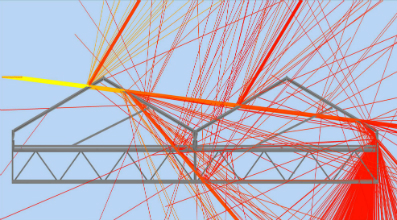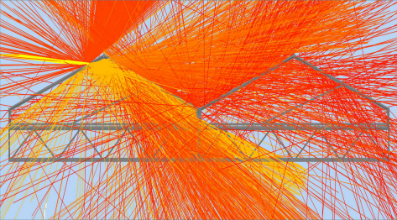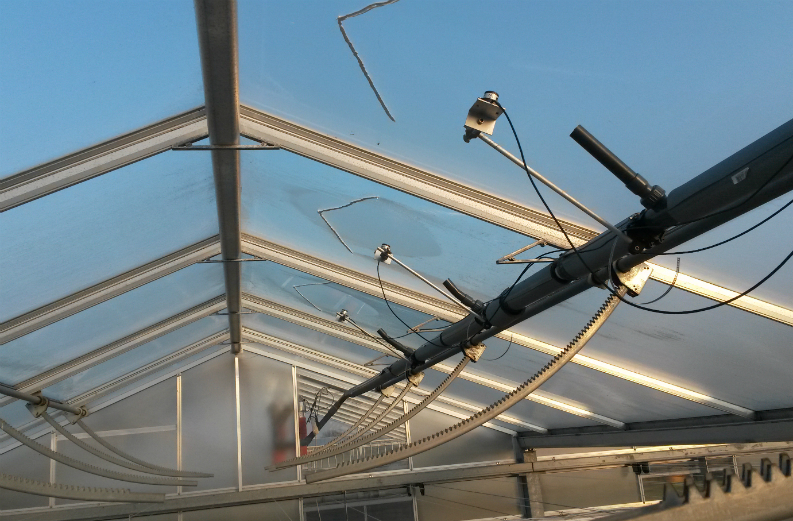In a current research project we are developing a new greenhouse and growing concept. The goal of the project is to develop a greenhouse for use in higher latitudes that will increase crop production during winter periods by at least 10%. This will largely result from technical innovations in the greenhouse construction, coverings and screens; optimised for maximum light transmission during the winter period with low irradiation.
Alongside that, crop variety and crop management have to be adapted in such a way that the crop uses the natural available light during winter more efficiently. A feasibility and pre-study has been carried out over recent months. Currently, the new greenhouse and growing concept is under development. We expect to build a ‘proof of principle’ greenhouse of 500 m2 in 2016 at the Innovation and Demonstration Centrum of Energy in Bleiswijk.
The project is financed by the research programme ‘Kas als Energiebron’, the innovation programme of LTO Glaskracht Nederland, and the Dutch Ministry of Economic Affairs. Various companies collaborate in the project; Bom Group (greenhouse builder), Glascom Tuinbouw (glass distributer), Ludvig Svensson (screen producer) and Nunhems (seed supplier).
In a feasibility study, different greenhouse constructions and glass and screen parameters were calculated with a ray-tracing model in order to determine the effect on light transmission during the winter months. Ray-tracing calculations show a very realistic simulation of the transmission of (sun) light through a greenhouse. On a greenhouse roof with a diffuse covering the light is much more scattered to the outside than on a greenhouse roof with a clear covering.
 A narrow light beam incident on a clear glass greenhouse roof
A narrow light beam incident on a clear glass greenhouse roof
 A narrow light beam incident on a diffuse greenhouse roof
A narrow light beam incident on a diffuse greenhouse roof
First results show that an East-West roof orientation of a Venlo-type greenhouse provides 2 to 4% more light inside the greenhouse for the crop during winter months, compared to a North-South orientation. In an East-West orientation a roof angle between 20 to 25° is optimal, both for clear and diffuse glass coverings. Changes in the greenhouse construction are possible and can lead to 2 to 4 % light increase and a new transparent screen material gives 2 to 4 % extra light. Highly reflective structural profiles used in the greenhouse roof construction give 4 to 6 % light increase.
Glass is available with anti-reflection coatings in order to minimise reflection losses and these increase the light transmission by 4 to 8 %. With angle-dependent optimization of coatings even more light can be gained in the future.
In order to validate the ray-tracing modelling results summarised above, different pre-studies have been carried out in which practical experiments and measurements have been conducted. One of these was the measurement of the effect of condensation on the inside surface of glass in a greenhouse roof on the amount of light available in the greenhouse. Crops always transpire water and the water vapour content in the greenhouse increases and it will condense on the inner surfaces of a cold roof. When droplets occur, the light transmission decreases.
 Condensation on glass surfaces with different hydrophobic or hydrophilic surface properties
Condensation on glass surfaces with different hydrophobic or hydrophilic surface properties
Since the inner side of a greenhouse roof is almost always wet during winter months in the Netherlands, the effect on light transmission is important. We carried out an experiment in which glasses with different condensation properties were mounted in the roof. Parts of the glasses were kept dry by blowing dry air towards the surface, on other parts condensation was allowed to occur.
In the experiment the amount of Photosynthetically Active Radiation was measured under the dry and the wet surfaces with Kipp & Zonen PAR Lite (PQS1) quantum sensors mounted parallel to the roof. In the experiment we found comparable values of light decrease on several wet materials compared to dry materials, as we already had predicted by the ray-tracing model simulation. Therefore, hydrophilic glass coatings are needed to reduce condensation and are able to increase the amount of light inside the greenhouse by up to 8%.
The next step will be the realisation of the proof of principle greenhouse and research on the performance of all the system parameters. Interactions between the individual effects occur and these will be quantified during the coming period.
 Kipp & Zonen PAR sensors under wet and dry greenhouse roof sections
Kipp & Zonen PAR sensors under wet and dry greenhouse roof sections
By Dr. Silke Hemming, Wageningen UR Greenhouse Horticulture, the Netherlands